For many of us who own chickens, the prospect of owning a rooster seems to be nothing but a downer: They’re incredibly noisy, often aggressive, belligerent, standoffish, and have a reputation for roughing up your poor girls.
This is all true, to an extent, but roosters can do a lot of good also. If you want to expand your flock the natural way you must have a rooster to service your hens, and they can be just the ticket to keep a free-ranging flock safe from predation.
Adding a rooster might be the perfect way to bring balance to your flock and your life on the homestead, but choosing the right kind is critical to harmony. I’ll tell you about 18 of the best rooster breeds to consider below.
Before You Commit, Consider the Size
One quick thing before we get to the list: we’ll talk about the essential traits of all of these different rooster breeds in time, but for now you need to assess the size of your new addition, and I’m not talking about headcount alone.
For starters, consider that roosters are very rough with hens when they mate. A large rooster paired with a much smaller hen could seriously injure her. And in reverse, a very small one getting with a large hen might fail entirely!
While the temptation to get a small rooster to make your life easy is certainly strong, and sometimes worthwhile, remember that a small rooster is going to have a much harder time effectively driving off any kind of predator.
Large roosters can be just as ferocious as many birds of prey on the other hand!
Keep these factors in mind and try to balance your different requirements before you commit to a rooster or two.
Silkie
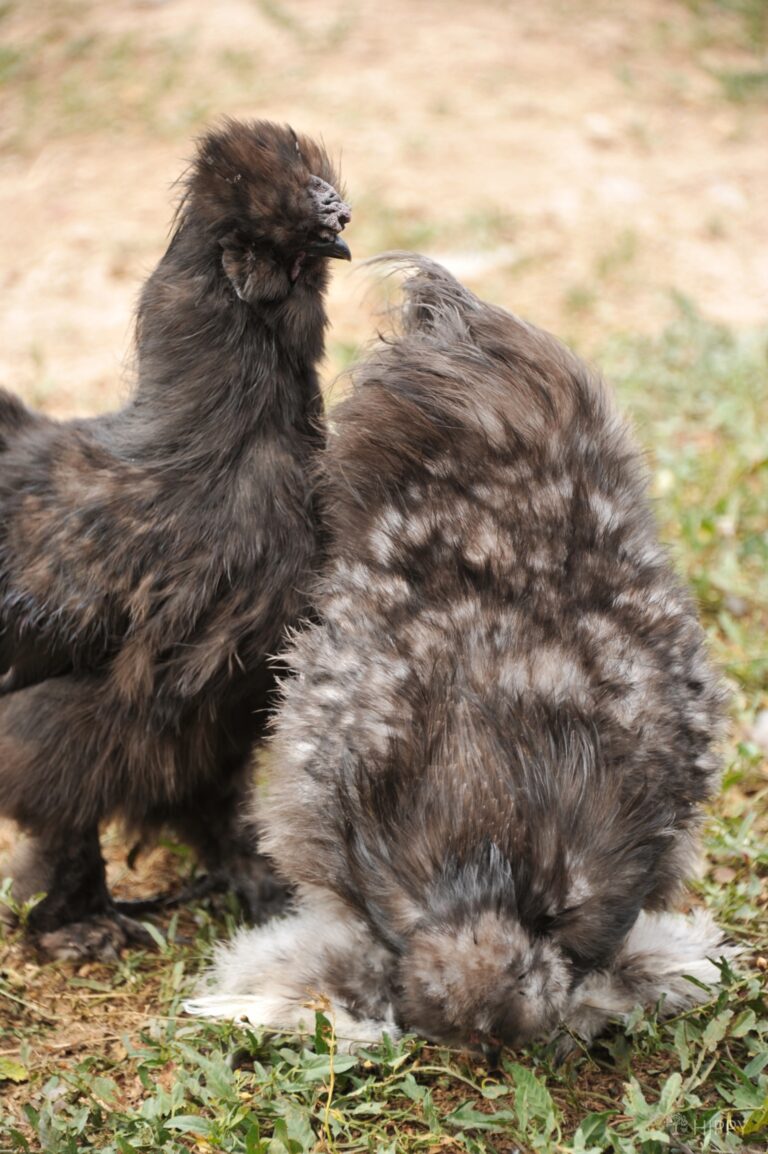
Available in bantam or standard sizes, Silkies, as the name suggests, are covered from stem to stern in amazingly plush, fluffy feathers that look more like fur.
This makes them the undisputed darlings of chicken shows and competitions, but like the Polish chicken, the abundant plumage greatly restricts their field of view, meaning they can rarely react in time to a quickly-closing predator.
Also, those fluffy feathers are extremely vulnerable to being caked with mud or ice, and that necessitates constant care from you.
Buff Orpington
One of the favorite chicken breeds around the world generally, and some of the best roosters around in a social setting, Buff Orpingtons are known for excellence in reproduction.
They’re extremely fertile and generally gentler with hens than most other breeds. They’re also famously good with chicks, and are one of the very best roosters if you want to expand your flock naturally.
Orpingtons also tend to be great with people, even kids, so long as they get plenty of socialization when they are young. Lots of benefits for a family-friendly and growing flock, but they aren’t the best on defense compared to other breeds showcased here.
Welsummer
Welsummers are a truly marvelous breed, known for their dark, desaturated, and almost gothic plumage, and high levels of attentiveness to the ladies and chicks under their care.
They try to keep all of their flock mates in view and sound off early and often whenever they detect anything unusual in the environment.
Not a great rooster if you live in the suburbs, I promise, but you can hardly do better if you want a genuine protector.
Believe it or not, they also have a reputation for being calm and patient with people- once again, so long as they are socialized correctly!
And even better, the breed is known to tolerate all kinds of weather with equal aplomb. An inspired choice if your flock needs a leader.
Brahma
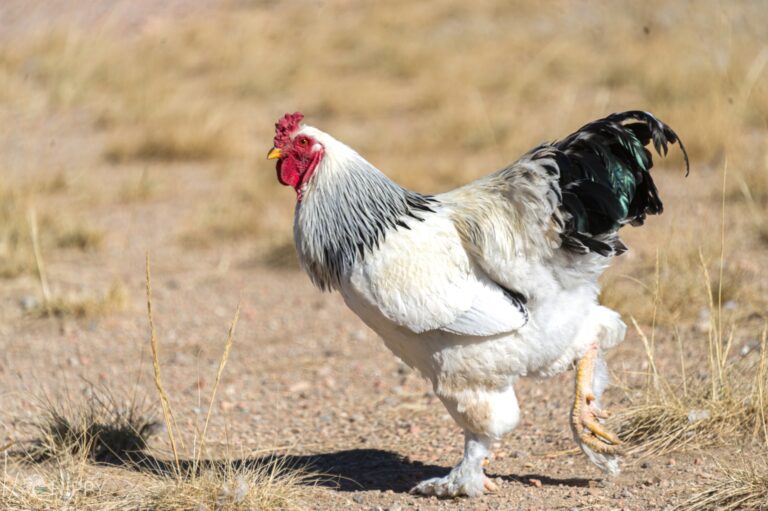
Gargantuan, stocky, and covered from head to foot in rough, fluffy feathers, the Brahma is one of the biggest domestic breeds around and is large enough to scare off lots of smaller predators, be they rodents or birds.
But what’s even more surprising is that Brahmas tend to be calm if not genuinely sweet-natured with their owners. This means you might not be running the gauntlet every time you need to enter the coop for something, or to catch your rooster for routine checkups or medication.
As always, you’ll need to put in the time to make them tame, but if you want a truly large breed that can take care of business, the Brahma is hard to beat.
Faverolles
One of the most majestic heritage breeds on our list, the Faverolle is a French chicken renowned for its regal posture and amazing coloration, consisting of black, speckled cream, mahogany, and white.
Faverolle roosters tend to be far more colorful compared to hens, but these brave birds aren’t just about good looks.
Though they are only a medium breed, they’re highly vigilant and quick to go into action when danger is near, and this is a stark contrast to their good nature and friendliness towards people when they are raised correctly.
The only downside is that they don’t do too well in the heat and tend to be quite costly. As long as you’re okay with that, Faverolles are a fine addition to most flocks. They also happen to be my personal favorite!
Java
Watchful, alert, and possessing strong corralling instincts Javas are good roosters for managing flocks that like to roam to and fro when free-ranging.
Although they are on the smaller end of the medium-size category, Javas are known to be enthusiastic fighters even when they are outnumbered or badly outweighed.
Javas are also healthy, hardy, and especially resistant to high temperatures making them a wonderful choice for those living in hotter climates. But, as you might expect, they don’t do too well in the cold.
Reasonably amenable to other roosters, an average Java only needs about seven or eight girls to call his own.
Jersey Giant
The Jersey Giant lives up to its name, with roosters tipping the scales at 13 pounds or even a little bit more.
When upright, these bruiser birds often clear 2 feet tall from their feet to their comb, meaning they are a reassuring presence to the rest of the flock and intimidating to any would-be predators.
Their sheer size means they are difficult for predators to deal with, and this can buy time for hens and chicks to get away when attacked.
Somewhat surprisingly, Jersey Giants are also pretty conscientious and known to find and alert the rest of the flock to the presence of edible bugs and other bits while free-ranging. These big birds are beautiful and dutiful in equal measure!
Langshan
If the noise typical of roosters is what has put you off from getting one until now, you should start your search with the Langshan. Although they’re hardly silent, Langshans are known to vocalize far less than other roosters.
This generally quiet demeanor in conjunction with their jet black and iridescent green plumage makes them an almost mysterious presence, but one you’ll grow to appreciate thanks to their diligence when it comes to watching out for danger.
However, they are known to be a little bit twitchy compared to other breeds and might maintain a standoffish attitude towards people even when raised with plenty of interaction.
Barbu D’Uccle
Barbu D’Uccle are incredibly photogenic bantams with hyperactive, inquisitive personalities.
Like most bantams, they don’t stand much chance with a large predator in a stand-up fight but that doesn’t mean they won’t fight to the death to protect their flock.
These little boys are brave to a fault, and can still do the job against snakes, mice, rats, and the like, and maybe drive off a few larger mammals.
Another interesting fact is that roosters are surprisingly caring, constantly on the lookout for extra food to share aside from watching out for danger. If you can get by with the limitations of a bantam breed, the Barbu D’Uccle is a fun addition.
Polish
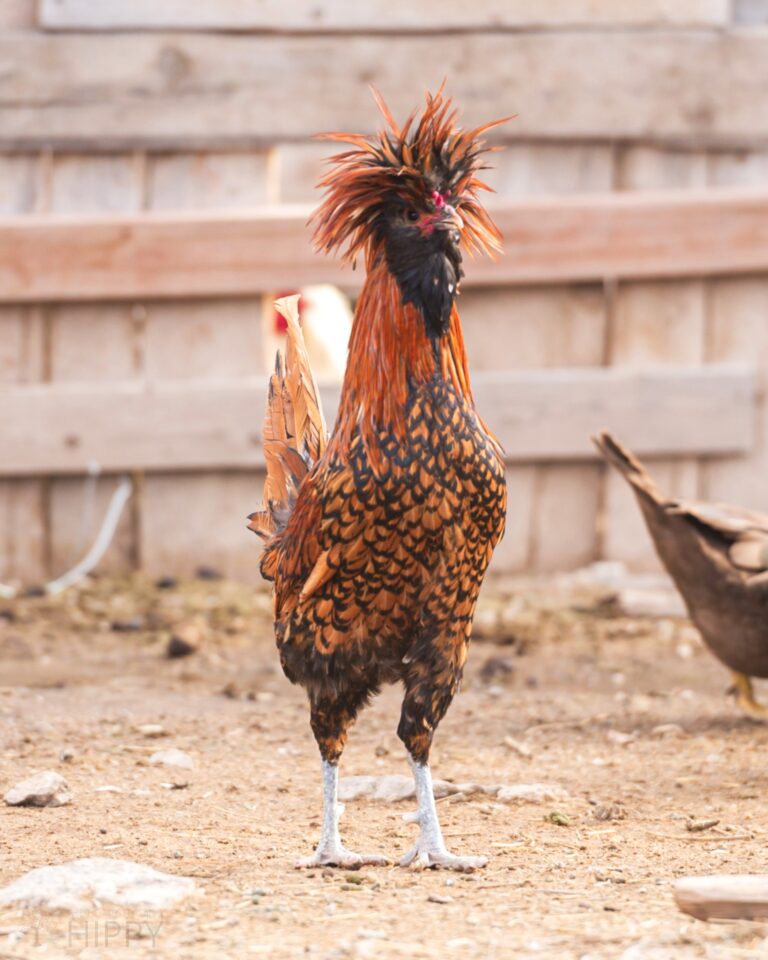
A fabulous and fantastically good-looking breed, Polish roosters are instantly identifiable by the large crest or “headdress” of feathers they have. If you want an awesome-looking chicken, look no further!
However, these good looks come with a decided cost: the feathers physically restrict the field of view of the rooster, making it difficult for them to do their job of detecting danger in time.
This also facilitates a generally nervous attitude, meaning your Polish rooster might be easily startled and go on the offensive if you surprise it… With some management, these drawbacks can be reduced but not entirely eliminated.
Rhode Island Red
Hardy and beautiful, Rhode Island Red roosters are American favorites, and motivated protectors of their flock. They tend to be especially alert to danger coming from any direction, be it above or through the grass.
You’ll love how healthy these birds are, but they tend to be extremely greedy of hens: A typical Rhode Island Red rooster will need at least 10 hens under his wing and they tend to rough up the females mightily when they do mate.
Consider chicken saddles mandatory if you want to protect your girls from missing feathers, dings, and dents.
Australorp
The sizable and statuesque Australorp is an excellent rooster if you want a diligent defender for your flock.
These birds are big and surprisingly athletic, amenable to a wide range of temperatures, and still good-natured with people assuming you raise them from chicks and spend plenty of time with them.
If you’re dealing with land-bound or aerial predators in an uncovered run or when your flock is free-ranging, the Australorp will prove to be one of the best guardians around.
They also happen to be great meat birds if you don’t want your rooster around for too long! However, Australorps tend to be pretty possessive, and will need at least 10 hens to themselves if you want to prevent problems.
Barred Plymouth Rock
Certainly one of the most picturesque and attractive roosters on our list, for many of the Plymouth Rock, with the Barred Rock being a know variation, is iconic when it comes to what a rooster is.
Upright, imposingly large and with flame-red waddles and a multipointed comb, they sure look nice… But make no mistake these roosters mean business.
Known for high intelligence and a strong corralling instinct that will keep hens from wandering too far, they are another excellent choice for an open run or for keeping your flock together when free-ranging over a larger area.
Just make sure they’ve got plenty of hens to themselves and they can even get along pretty good even with other roosters once they figure out the pecking order.
Sussex
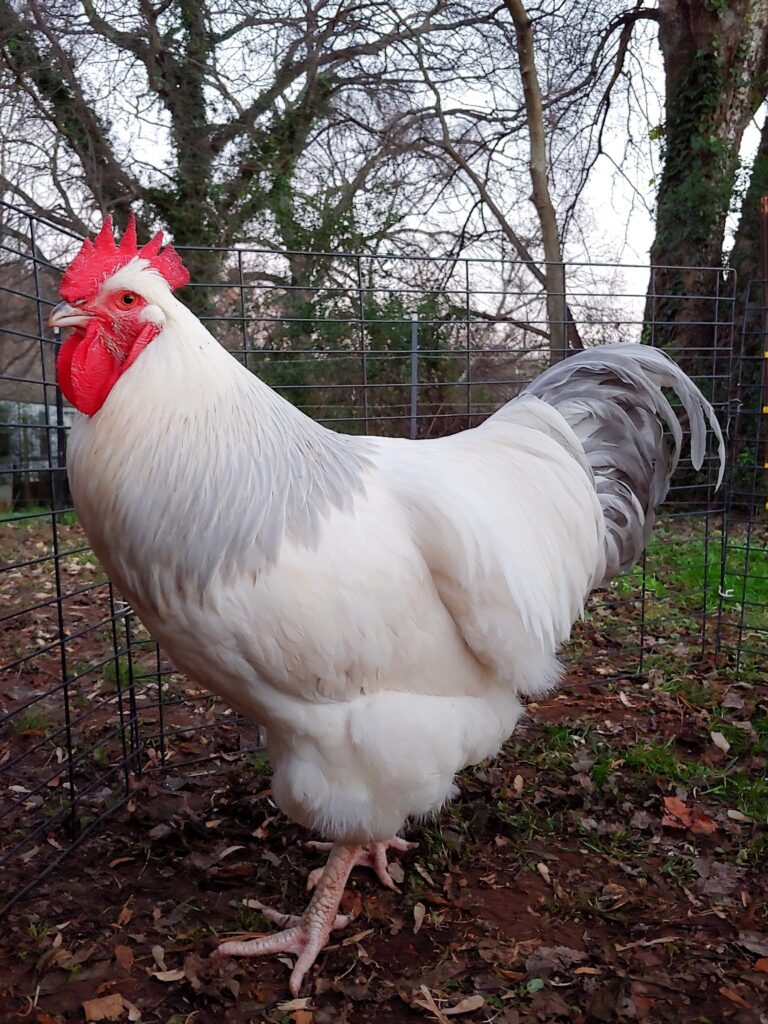
Another classic heritage breed that is famously good-looking, Sussex chickens are a wonderful choice if you want your flock to live as nature intended.
Not only are they highly fertile, but they’re very quick on the draw when it comes to predators and will intervene in a flash and fight to the death if required. You can’t ask for more than that from a good rooster.
But, like the Rhode Island Red and other breeds elsewhere on this list, they only do well in flocks where there are plenty of hens for each rooster. Fights between the boys will be legendary if there aren’t enough girls to go around!
Sebright
Sebrights are tiny bantam roosters. And I mean really tiny: roosters rarely reach even 1 ½ pounds.
Despite their diminutive stature, Sebrights are notoriously hyperactive when it comes to protecting the flock. That includes, unfortunately, protecting them from you!
You’ll have to work with your Sebright constantly if you want him to be a part of your family and not just an overzealous guardian of your flock. While they aren’t much force to defend the flock from anything larger than a rat, they do make a great early warning system!
Serama
Variably known as the Malaysian Serama or the Pygmy chicken, the Serama is the smallest recognized breed of chicken in the world, though it is a fairly recent import to the West. It’s also famous for being a true bantam with no larger equivalent breed.
Although these roosters are diligent and hardy, they tend to be more than happy to follow people around. Maybe they are thinking that the larger, friendly mammal is their best chance at defense!
In any case, if pressed into a fight they will fight ferociously though this is one rooster that is always going to be badly outgunned by anything bigger than a mouse.
Seramas are also infamously intolerant of any other roosters, even their own kind, so they’re best as a lone addition for small or separate flocks.
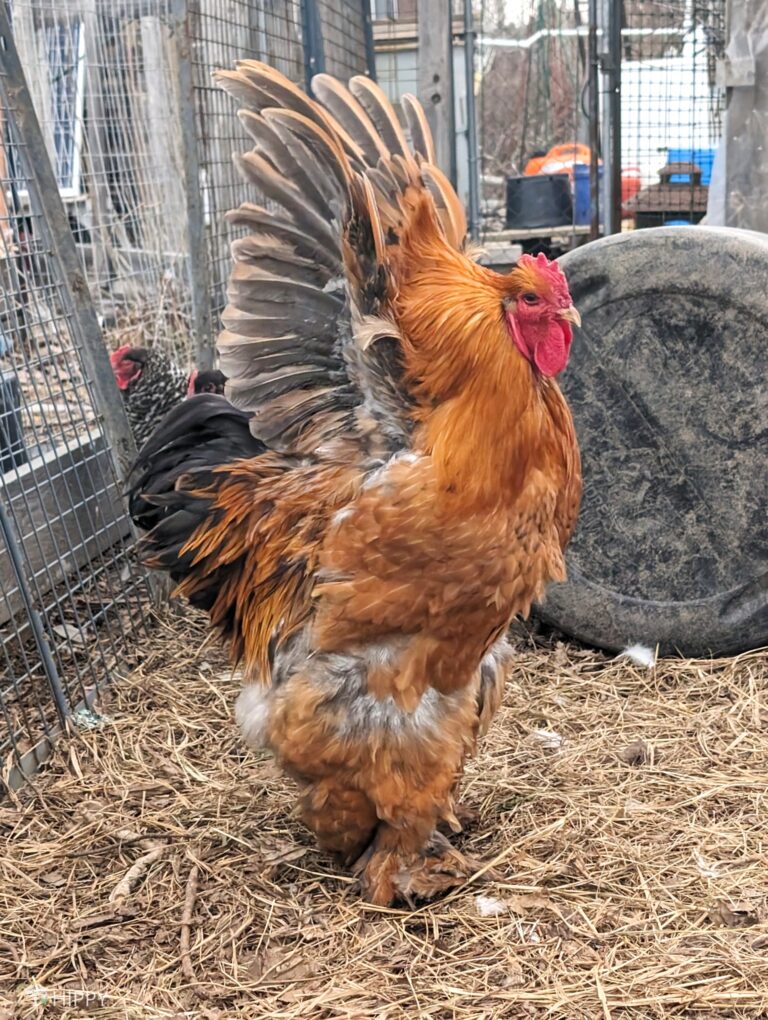
Cochin
Another very large breed, Cochins are attractive and resistant to cold weather although they don’t do so well in the heat.
If you want a rooster predominantly for reproduction and not for protection, the cochin can make a good choice due to their overall fertility.
Roosters even help out with raising young chicks and can handle a higher number of roosters in the flock compared to other breeds, typically needing only about five or six hens to call their own!
However, they are nowhere near as aggressive or quick to defend as other breeds on this list, so think twice if predators are a major problem around your homestead.
But, assuming you’re protecting your birds in other ways or just don’t have that many large predators around, a Cochin is a rooster you won’t regret.
Delaware
Among the most attentive and dedicated rooster breeds, Delawares are medium-sized birds that can handle a wide variety of temperatures, though they tend to do somewhat better in cold than in intense heat. They are very alert to any possible danger, but as a natural consequence,
Delawares are far more vocal than some other roosters. This means that false alarms and calls are a regular occurrence in the flock.
But, when the time comes, they’re also very stalwart on defense though they will struggle to buy time against the largest chicken predators owing to their modest size. All in all, an excellent all-around choice and a pretty good table bird in the bargain…
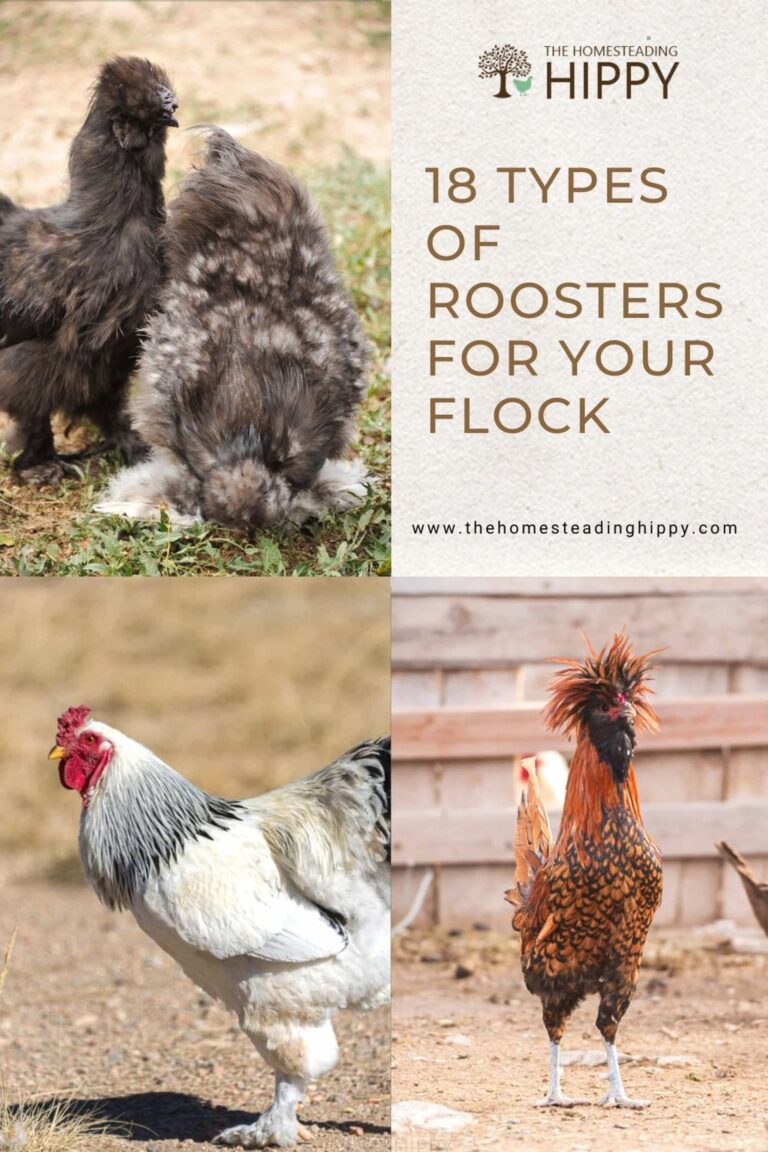
Tim is a farm boy with vast experience on homesteads, and with survival and prepping. He lives a self-reliant lifestyle along with his aging mother in a quiet and very conservative little town in Ohio. He teaches folks about security, prepping and self-sufficiency not just through his witty writing, but also in person.
Find out more about Tim and the rest of the crew here.
